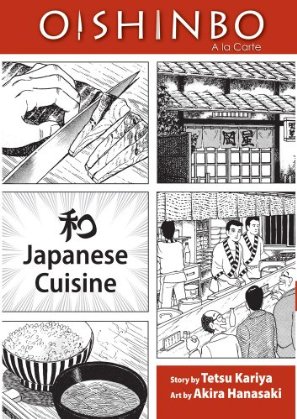Manga Selection: Oishinbo

Oishinbo is more than a manga, it’s a window into the
foundations of Japanese society itself, the way all cultures differ and
share similarities, food. The manga has since become essential, sold in book
stores anywhere with manga and even airport stores in Japan, just to give you
an idea of it’s influence, as well as it’s representation of a country with
pride in its traditions that has remained intact even to this day.
Each volume is
dedicated to a particular food group such as rice, vegetables, and fish
and so on. They draw from a 100 volumes in a series that is still ongoing,
highlighting some of the best chapters or the most relevant to what each
volume is about. Food groups used in Japanese cuisine and that’s the thing, this
isn’t just food but dishes that are prepared as fine culinary dishes as well.
Yamaoka Shiro along with his co-workers work for a newspaper Tozai Shimbun, preparing to present a
spotlight they call the ultimate menu, which finds them seeking out the best of
the best for each dish, even the intricate aspects that go with these dishes.
Though each
volume is divided into a topic (sort of), there is plenty to explore within it and the
first volume shows more than what’s expected, even preparing what seems simple
like the perfect miso soup or green tea or even the proper dishes and cups to
serve them in. Why not even have one that focuses on the chopsticks themselves,
yes it is an experience you’ll relish as you read it. As insightful as it was
when the manga first started in the 80’s. Natural taste and seasoning, the
right balance, where they come from and how they should be used.

Quite the task
no matter who undertakes it, luckily for the magazine they have Yamaoka Shiro.
While he may seem disinterested and bored, Yamaoka is extremely knowledgeable
about Japanese cuisine, understanding the complex aspects of dishes and why the
simplicity sometimes is the key. It also helps that he knows legends and
unknowns in the food industry that can bring out the taste and was raised in
the kitchen much to his benefit and his dismay.
How he has
obtained such a keen knowledge for such things bothers him more than he cares
to admit, especially when he finds the magazine will have to deal with a rival newspaper working on what they're calling the superior meal assisted by the
top gourmet, his father Yuzan Kaibara. The two can hardly be in the
same room together without shooting daggers at each other with their eyes. When
Yamaoka was younger, his father was demanding, overbearing, everything needed
to be perfect to his taste. His job and his home life inseparable had forced Yamaoka’s mom to redo meals over and over again.
Even his father’s cooks had to walk on eggshells and for this reason there was
never an enjoyable moment without incurring his father’s wrath.

Still these
circumstances have given him the delicate, sensitive taste buds and the keen
eye for what Japanese cuisine should be.
Even so the author can’t help but bring these two together and this
first collection of stories sees this face off quite often. Now the volumes are collected stories so they shoot through the time line but still you can't help but feel like the editors enjoyed the father and son showdown to splice so many so close together. At times it even
misguides Yamaoka who goes against what he would normally do in order to
prepare a dish just to try and best his father, with results that make his
regret this choice. Though sometimes it feels as though his father is guiding him, teaching him even in his own stuck up way.
One thing it never
does is distract you from what the manga is all about. Informative and loving
for the art of Japanese cuisine, it’s challenges what people know in order to expand it and as an effect brings people
together. Yamaoka tends to help struggling cooks or preparing a menu or get
volunteered into something when someone visits the office. When it isn't these situations, it tends to be someone disliking a dish and having to be proved wrong, there's other rivalries and other personal social issues that come up and attached themselves to the food storytelling. These usually take readers through particular
taste which come with a bit of history. Even if Yamaoka is unwilling and his
co-workers have to drag him along.
 Many dishes or
explored and the author doesn’t leave you wondering how the meals are prepared,
providing recipes to many of the dishes. However what is interesting is the
length Yamaoka goes or other cooks go to prepare these dishes. There is even a
scene where Yamaoka jumps into the water in order to obtain the right ingredient
for a meal he is preparing. Oishinbo was a part of the movement during the 80’s
called the gurume movment ( the gourmet
boom) and yet managed to stand apart from the rest and is still an enriching experience.
Since it’s publication the manga has received numerous awards and is still one of the
longest running manga titles even though it’s run into a bit of a hiatus in the last
couple of years.
Many dishes or
explored and the author doesn’t leave you wondering how the meals are prepared,
providing recipes to many of the dishes. However what is interesting is the
length Yamaoka goes or other cooks go to prepare these dishes. There is even a
scene where Yamaoka jumps into the water in order to obtain the right ingredient
for a meal he is preparing. Oishinbo was a part of the movement during the 80’s
called the gurume movment ( the gourmet
boom) and yet managed to stand apart from the rest and is still an enriching experience.
Since it’s publication the manga has received numerous awards and is still one of the
longest running manga titles even though it’s run into a bit of a hiatus in the last
couple of years.
Though it isn't the first time, the recent one was shortly after a bit of controversy. It goes back to 2014
where the author received criticism for the way he depicted a story that
referenced the Fukushima Nuclear Plant post meltdown. The largest nuclear
meltdown since Chernobyl, which happened as a result of the 2011 Tsunami in
Japan, knocking out generators and back-up generators. In the story, a journalist finds himself getting
sick shortly after visiting the Fukushima plant. Shortly after the manga went
on hiatus though the editor insisted that it had been planned beforehand.
Naturally the
concern came from how the public would react, fears of fish from the area being
tainted with radiation and many wanted to assure there was no cause of concern.
On the other side there are some that will defend the comic, speaking out on
the symptoms that they have, similar to those of the character in the story “The
Truth of Fukushima.” Tetsu Kariya, author of the manga defended the story even
if the reaction came as a surprise, it was a story that was researched for two
years and something he and the others that worked on it wanted to stick by.
As are all the
stories in the manga you see, heavily researched to give an authentic view on
Japanese culture, when you become this iconic of course it can cause a wave of
reactions. Manga is versatile like all comics, anyone that would try and argue
this fact has never heard of Oishinbo. For years Oishinbo has stood out as an
important cornerstone not just in manga but in all aspects of Japanese culture.
As the author says, it’s something to bring us all together so it may just be a
manga about us as people in general and that comes from the joy of food.
A Podcast Companion
*Need more otaku time, well for more ideas why not hop on to the newly minted podcast Rats On A Plague Ship. A podcast that speaks on all matters of geekdom with yours truly and my fellow co-host Sal Almaraz. The true cure to when the hours feel like they drag!
No comments:
Post a Comment